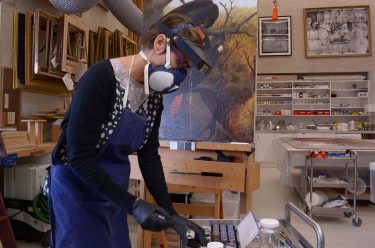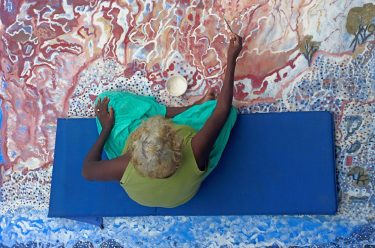Watch our time-lapse as Anthony Alder’s original colours are restored in Heron’s home 1895 showing the full tonal range and sharpness of colour. A final varnish layer on a finished painting has been an artistic practice for centuries. Artists often apply a transparent varnish to give saturation and their desired level of gloss to the painting, as well as to provide a protective coating.
Until the 20th century, natural resins such as dammar and mastic were usually used. Over time these varnishes can become discoloured as the resin degrades, eventually causing a yellow to brown colour shift to the artwork. Whites look a dirty yellow, while blue skies are transformed to a stormy green.
Before conservation

After research and discussion with curators, a conservator may choose to remove a discoloured varnish if the removal can be done safely without risk to the underlying paint layers. This was the case with our recent acquisition Heron’s home by Alder, a Queensland colonial artist and taxidermist. Dating from 1895, the painting depicts two meticulously rendered Nankeen night herons in a riverine landscape, but the deteriorated varnish was giving it a strong yellow cast overall.
Watch as I remove the varnish layer using cotton swabs and a carefully-tailored solvent blend. The artist’s original colours are restored in Heron’s home showing the full tonal range and sharpness of image.
Jocelyn Evans is former Conservator, QAGOMA
Watch | The transformation
After conservation

#QAGOMA


Wow! What an interesting time-lapse.
The difference between the ‘before and after’ is quite remarkable.
I am interested to know whether a new layer of varnish is applied to the work once cleaning is complete? If not does this render the work slightly more vulnerable?
Alexandra
Hi Alexandra
Yes, removing a degraded yellow varnish really can alter the look of a painting – the green skies become blue again and the yellows become whites. A new varnish was applied to this painting after the yellow degraded varnish was removed. Alder was working in a traditional manner and his oil painting technique relies on the saturation of his colours by a final varnish. There has been a lot of research into finding varnish resins which have a longer lifespan than the traditional dammar that Alder probably used. These new resins used by Conservation are designed to last up to 100 years without yellowing, and to remain solvable in a solvent that does not affect the oil paint – all this while maintaining the refractive index and gloss of a traditional varnish. Traditional varnishes may yellow after 30 years, and this creates a cleaning cycle which is not great for the painting.
Many artists however choose to leave their oil paintings unvarnished. Some paintings have been mistakenly varnished by collectors over the years, and when these paintings are cleaned of their old varnish, a new varnish is not applied. This does leave the surface more vulnerable, but is a valid choice for an artist who likes a matt surface. With particularly vulnerable unvarnished paintings, we sometimes add glazing into the frame – a layer of laminated glass or acrylic in front of the painting to protect it.
Regards Anne, Conservation